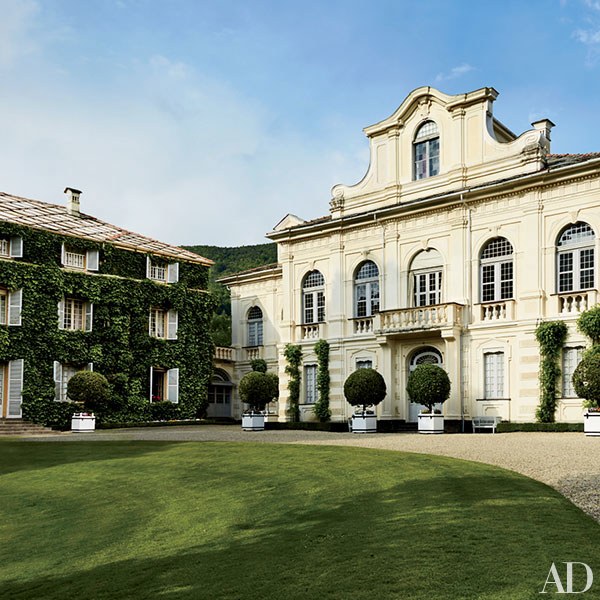
It was a sad week with death of Lee Radziwill followed up with the passing of Karl Lagerfeld and Marella Agnelli. I noted on Instagram that we’re losing all the elegant ones this week and my friend Starrett followed up by saying, “It’s like elegance stood up this week, looked around, didn’t like the room and left.”
All three epitomized style and elegance in relation to fashion and interiors. Each lived in iconic homes and none more so than Marella Agnelli. After she married Gianni Agnelli in 1953, she would be charged with decorating and entertaining in some of the most beautiful homes around the world. Lucky for us, Marella outlined many of them in the book Marella Agnelli: The Last Swan that she wrote with her namesake niece, Marella Caracciolo Chia. The most emblematic of the Agnelli’s was Villar Perosa outside Turin, Italy. The Agnelli family had acquired the Piedmont Baroque estate in 1853, long before FIAT was established.
“Perched high on a hill overlooking the Val Chisone, halfway between the Po Valley and the Alps, the villa’s symmetrical facade stands out against a backdrop of thickly planted forests. From it’s arched entrance, one accesses the grand double staircase leading up to to the gallery on the first floor, an exuberant network of painted stucco vaulted ceilings, chinoiserie-style painted wallpaper, and ornate garlands heralding the approach of the rococo style.”
“Every time I create a home or a garden, I ask myself the same questions, where will we gather together in the daytime and in the evening? How can I preserve a few quiet, secluded spots for reading or working? Which is the coolest area in the garden for meals in the shade? Architecture and landscapes influence our lives so much—I’m always fascinated by that.”

“I had grown up in, an isolated, slightly conservative world known as the anglo-beceri. It was inhabited mainly by wealthy Anglo-American expatriates, like my mother, and members of the old Italian aristocracy, like my father—a set of people who spent their days visiting one another’s exquisitely refined gardens and crumbling villas on the hills of Florence and getting into interminable philosophical disquisitions.”

“One day, not long after our wedding, I decided to go to Paris for a few days of shopping. The best way to get there at the time was to take the night train from Turin. When I arrived at the station to meet up with my friends, I found a surprise waiting for me. The wagon-lit I had booked looked familiar: towels with my initials had been neatly placed in the bathroom, together with my favorite soaps and creams. The train sheets had been replaced with ones from home, with Gianni’s and my initials on them. There was even a vase with fresh flowers! It had been Pasquale, the butler, who had arranged it all. This, I soon discovered, was how the Agnellis traveled when they took a night train. This was also when I realized I had entered a very different way of life from the one I was used to.”

“The first few months after our wedding, I spent hours every day on the sofa, just reading. Now that I no longer had a proper job, life felt like a permanent holiday! Gianni was worried. He could see I had no aptitude for domestic concerns. One day I received a phone call from Contessa Volpi, a Venetian “dragoness” who owned magnificent houses and was known for her savoir faire as a hostess. Gianni had obviously asked her to come to my rescue. “You must come and see me,” the old lady roared imperiously into the phone. “I hear that you don’t know how to run a home.” That’s when she told me a line I shall never forget: “Remember, my dear girl,” she said, “all one needs to catch a husband may be a bed, but it takes a whole house to keep one!”

“Contessa Volpi taught me many things, some more useful than others: how many pairs of sheets one needs for each bed, where to have them embroidered with one’s initials, how many porcelain services one needs—things like that. She also gave me counseling on the number of servants needed for each house, where to have their uniforms made, and how to manage their working hours. She taught me the importance of good “placement” for formal dinners and how to create a successful menu. Contessa Volpi tried to teach me to be parsimonious, something she excelled at. After every dinner she personally smashed all the empty wine bottles. “But why?,” I asked naïvely. “That way,” she answered, “staff won’t be tempted, at future dinners, to claim that more wine has been consumed than in reality, swindling the extra bottles for themselves.”

“The classical decorator Stephane Boudin had already restored a portion of the house damaged by bombing in World War II, and he continued to assist the newlyweds. Marella and the puckish Parisian collaborated with purposeful sensitivity. Gianni’s parents and grandparents had died when he was young, leaving behind rooms furnished with memories, so his bride, the daughter of a Neapolitan prince and a mother from Peoria, Illinois, was determined to tread softly.”

“Boudin and Marella refreshed the piano nobile’s famous gallery, where exuberant stuccowork frames 18th-century Chinese export wallpaper and garlands the ceiling. They upholstered the villa’s antique Piedmontese chairs and settees—painted in pale, pretty colors that bring to mind macarons—in bold French velvets and Italian silks, and made-to-measure sofas added modern comfort. Alongside the main dining room, they set up a cozy library for after-dinner coffee. A few guest rooms became perfect expressions of ancien régime French taste, the decorator’s specialty. Boudin’s friend Russell Page, the British garden genius, helped Marella clarify the landscape, which she described as having been “a patchwork, each area created by a different generation.”
The Chinese Gallery refreshed by Boudin.
N.B. Renzo Mongiardino did not work on Villar Perosa. He helped Marella bring to life the Villa Frescot another Agnelli home in Turin as well as one of their apartments in New York.
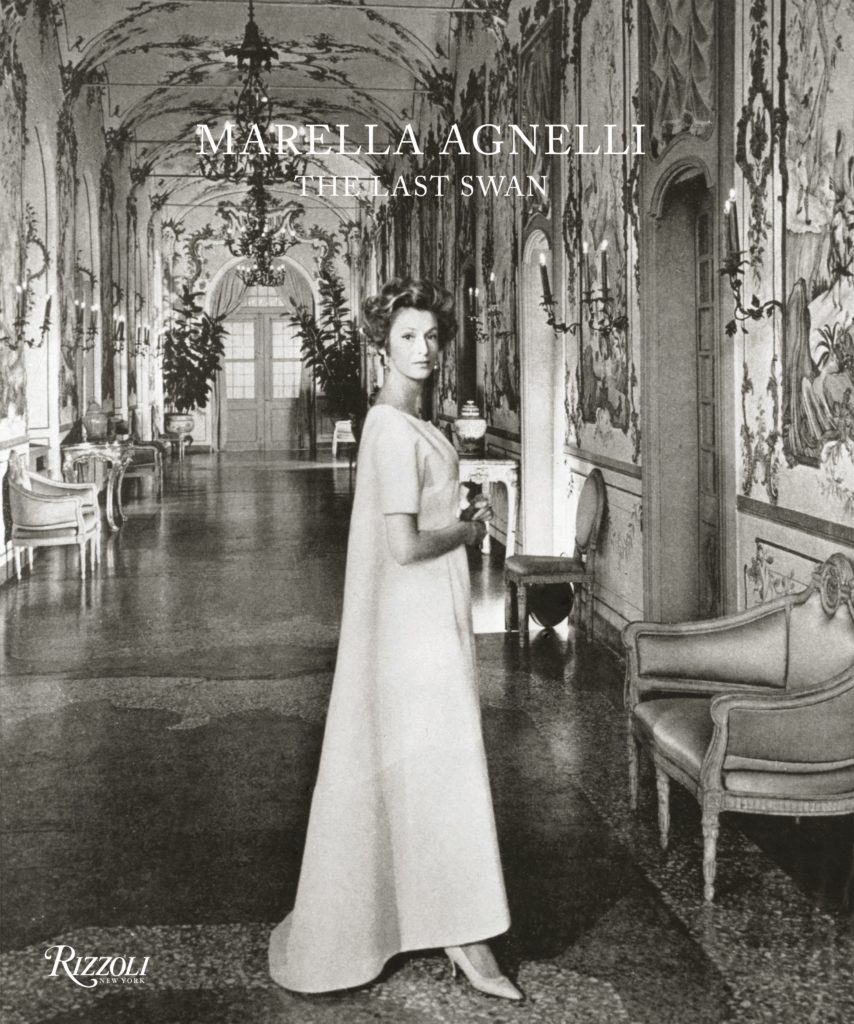
Marella Agnelli, photographed by Henry Clarke in the Chinese Gallery in 1962 graces the cover of Marella Agnelli: The Last Swan.
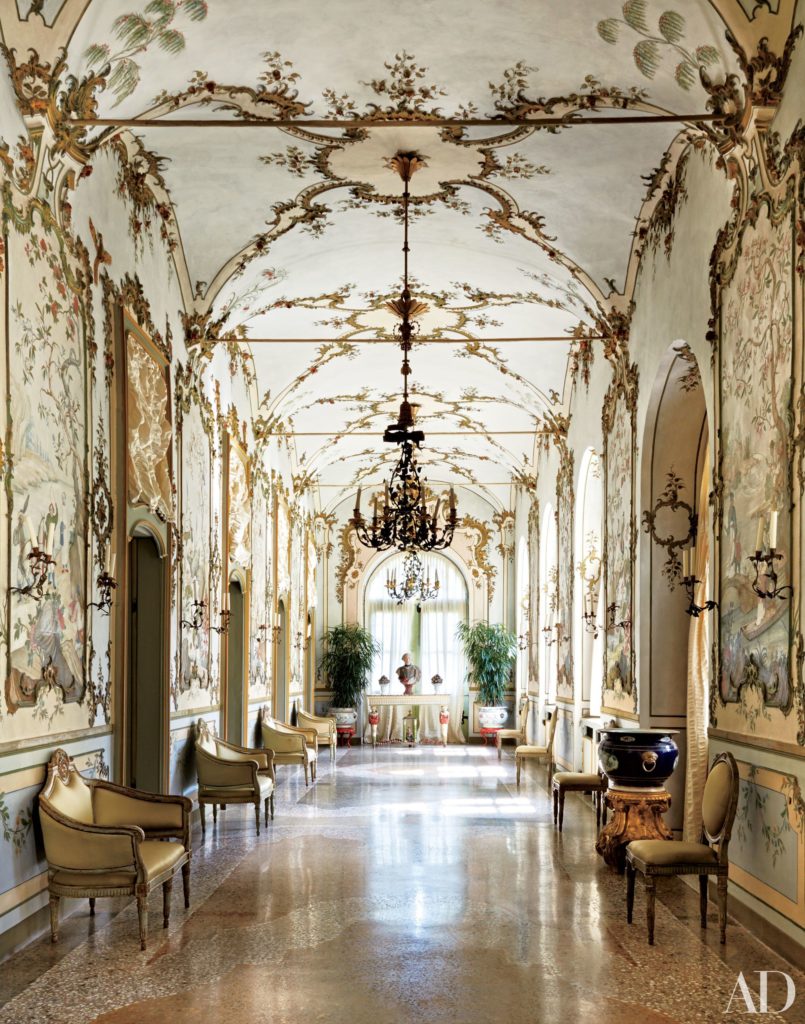
Another view of the Chines Gallery from AD.
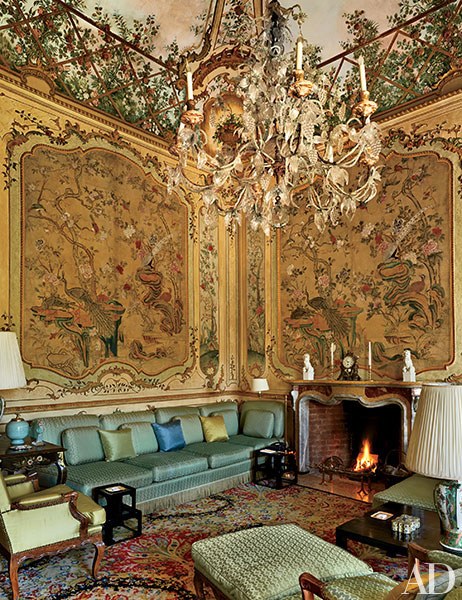
“A sofa designed by Stephane Boudin spans one end of the piano nobile’s main salon, which is decorated with panels of antique Chinese wallpaper and an Italian chandelier dating from the 18th century.”

Marella Agnelli in silk palazzo pajamas by Federico Forquet, photo by Horst in the main salon of the Villa Perosa in 1967.
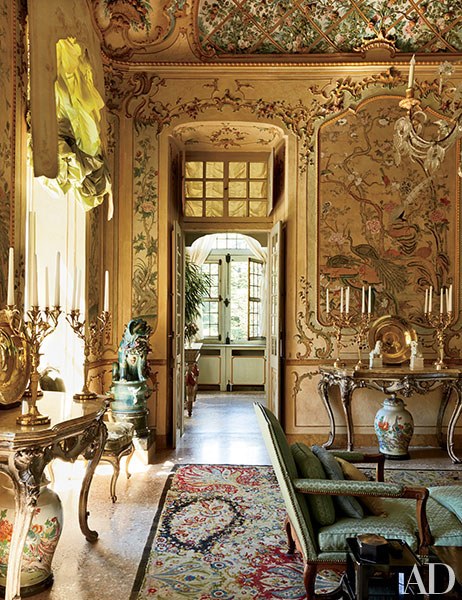
“Eighteenth-century painted-stucco decorations enliven the main salon on the piano nobile; the consoles are Piedmontese antiques, and the open doors lead to the famous Chinese Gallery.”
From How to Spend It, “Marella bought her candles in a small shop in Turin called Conterno. Founded in 1795, it still makes candles the traditional way. It has no website, and chic Italians around the world receive theirs by mail order. Agnelli’s favourites were the 20cm and 30cm examples that taper at the top, designed for candelabras.”
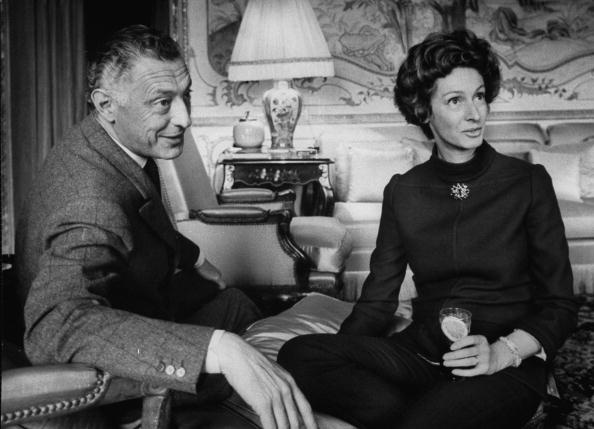
Marella and Gianni Agnelli photographed in the main salon in 1967.

An 18th-century landscape by V. A. Cignaroli is hung above a sofa in the second salon. An easel holds a painting of the Marchioness of Prie, a former owner of the villa, and the carpet is an antique Aubusson.

I came across this photo of the second salon from a photo shoot of Marella’s granddaughter, Ginevra Elkann, in Vogue Italia. It shows the furniture covered in white slipcovers but I’m not sure if this is done for the summer months or to protect the furniture while the family is not in residence.
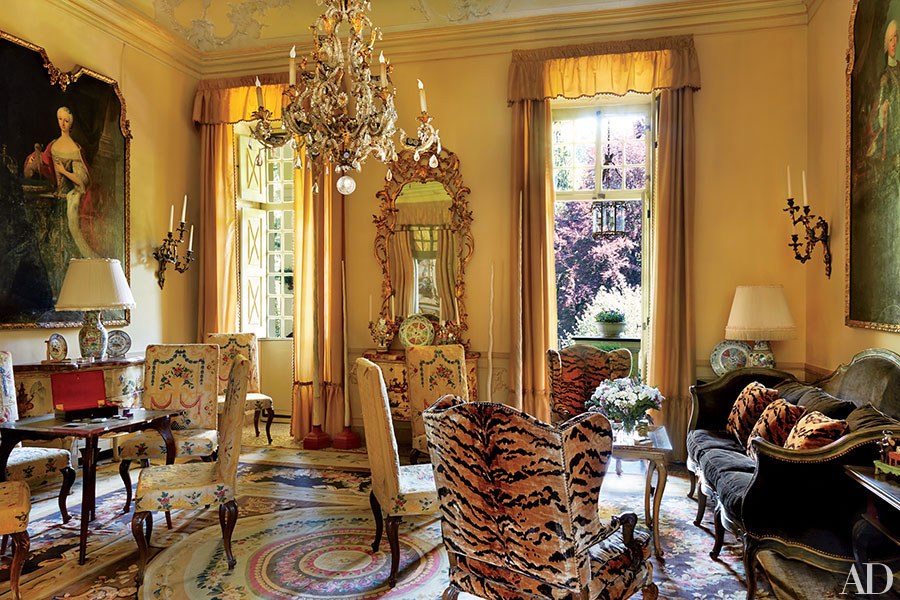
Card games were traditionally played in the salone da gioco, where 18th-century Piedmontese portraits of a king and queen of Sardinia are displayed.
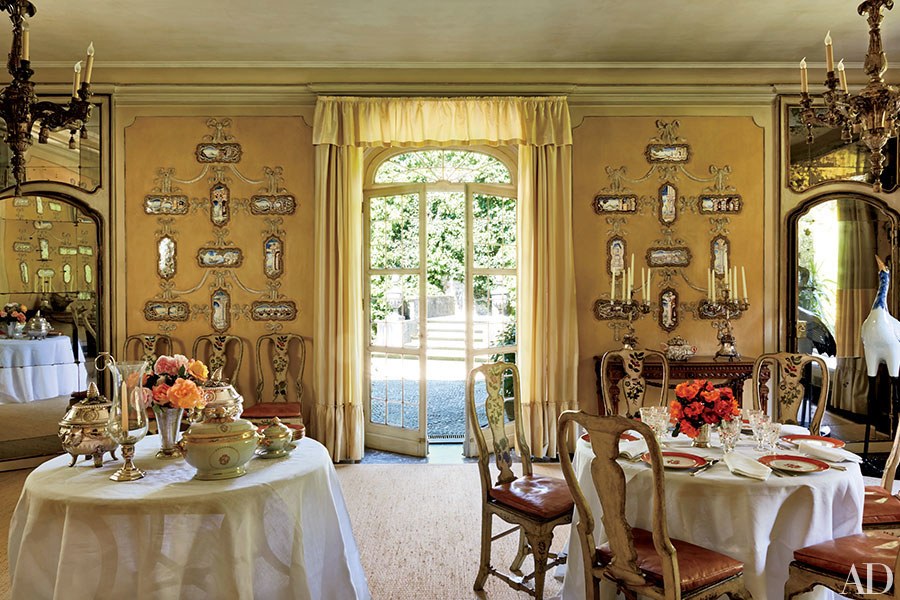
Majolica plaques ornament the walls of a dining room filled with antiques.
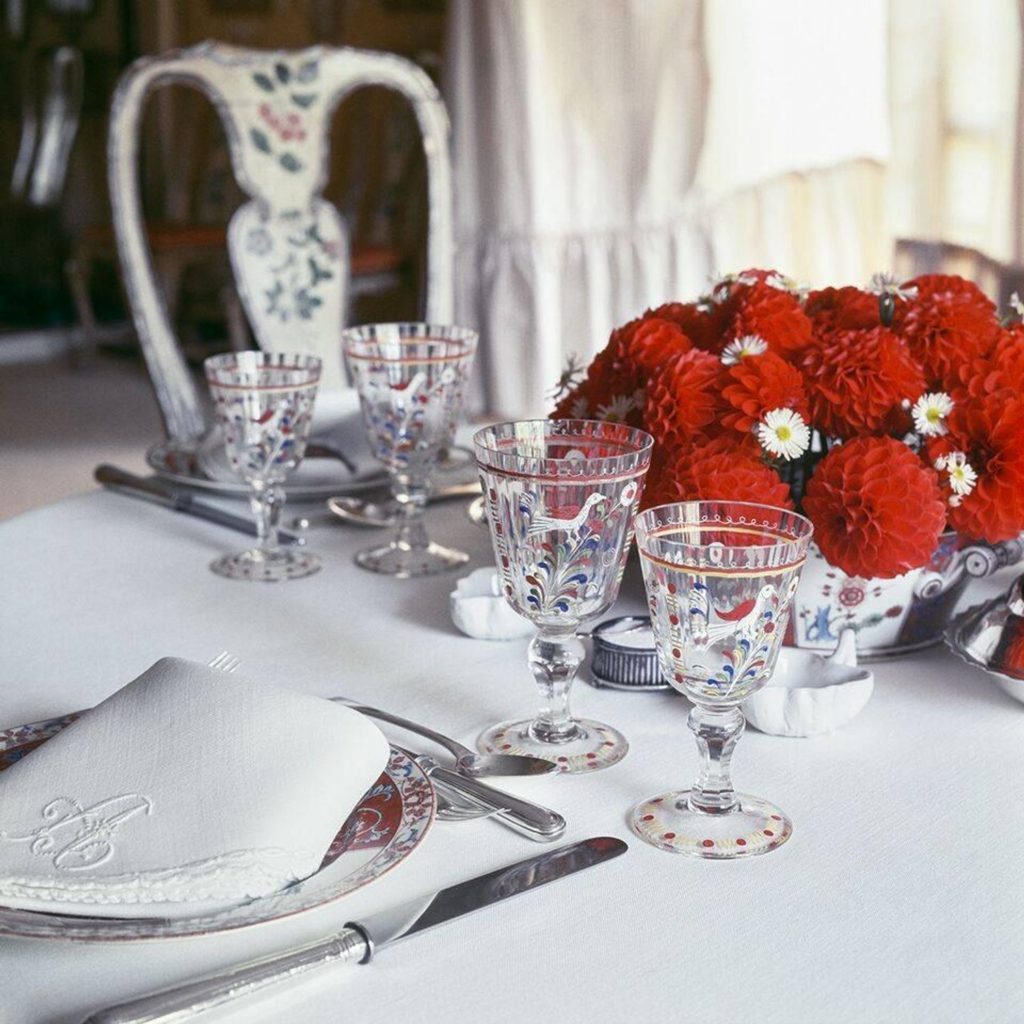
One of my biggest frustrations on Instagram is seeing how many people don’t know how to properly set a table. The worst offenders are those who don’t know which side of the plate to place the flatware and those who don’t know that knife edges should always face inward toward the plate. It’s also sad that billionaires these days are wearing hoodies and eating Soylent at their desks instead of throwing elegant dinner parties like the Agnelli’s.
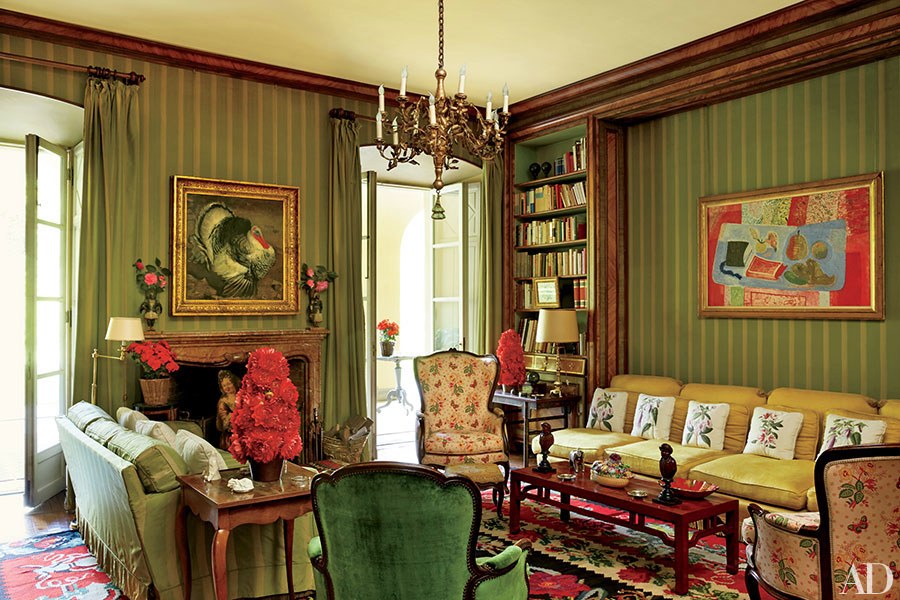
A painting by Armando Spadini hangs on the left and one by Emmanuel Gondouin hangs on the right in the library, which was created by Agnelli and Stephane Boudin in the 1950s. The sofa is a Boudin design. The dahlia floral pyramids are an Agnelli hallmark.
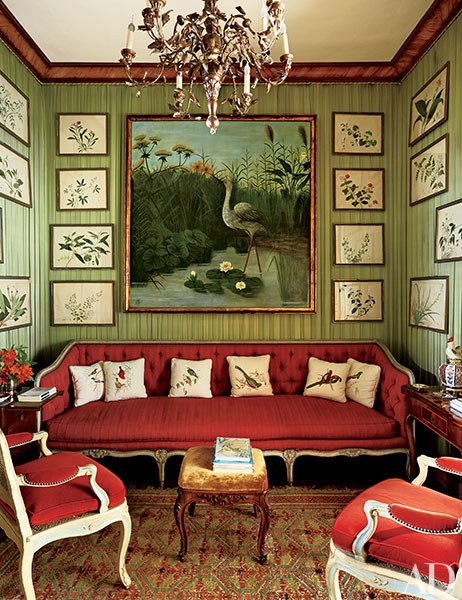
Finely pleated fabric lines the television room; an 1880s Louis Vivin painting of a heron hangs above the antique sofa, amid 19th-century botanical illustrations.

Marella’s private reading room. From How to Spend It, “Agnelli’s houses were not only always filled with fresh flowers, but they were also beautifully scented. For potpourri she almost always went to Agraria, most specifically for the bitter orange or the lavender and rosemary. Dotted round the house too were pretty painted glasses for pens and pencils, as well as other small containers, bought from Doris Brynner’s jewel of a homeware section in the main Dior boutique on Avenue Montaigne in Paris. Her favourite source of exquisite handmade and embroidered children’s clothing and bedlinen was a traditional little Roman outlet – Lavori Artigianali Femminili – which offers a very personal service.”

Another look at Marella’s private reading room with her bedroom beyond.
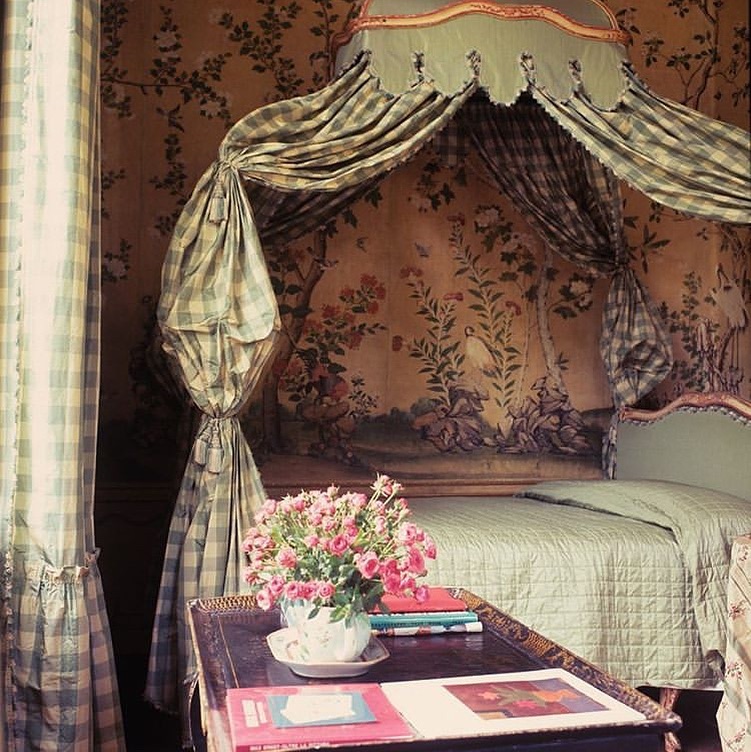
Marella’s bedroom with sage green quilted silk on a Louis XV Piedmont bed and a checkered taffeta baldachin in a photo from 1967.
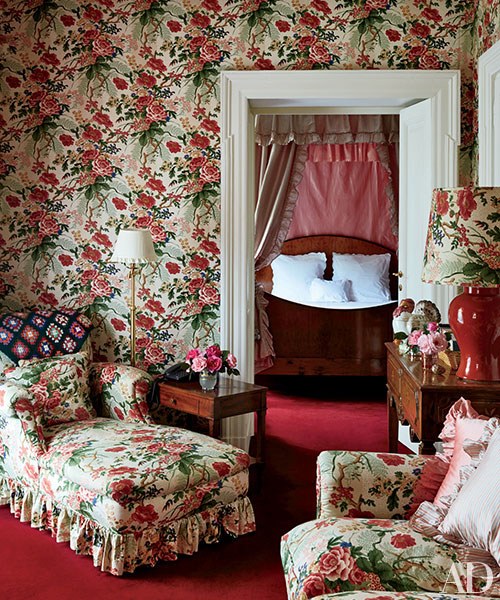
On the top floor, the suite belonging to Marella Agnelli is embellished with a lively floral pattern. “Then, 30 years ago, the frequent presence of eight lively grandchildren prompted Marella to transform a portion of the top floor into a private sanctuary. Following the advice of an old friend, decorator Federico Forquet, she fashioned four bedrooms. Among them is her intimate, low-ceilinged suite, lavished from walls to lampshades with a peony pattern.”
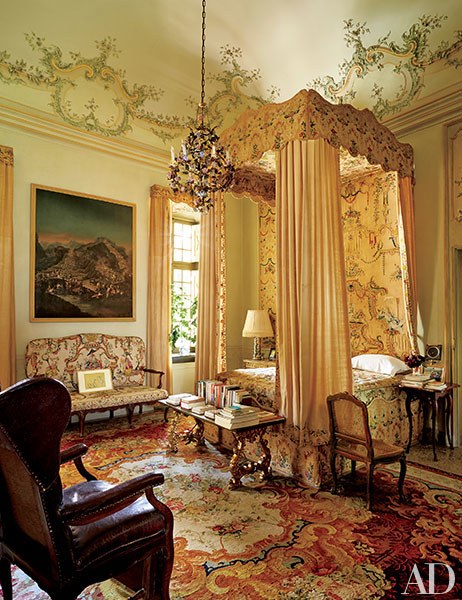
“For more than three decades, her husband, Gianni Agnelli, slept in this grand room on the piano nobile; the 18th-century bed is curtained with embroidered fabric of the same period.”
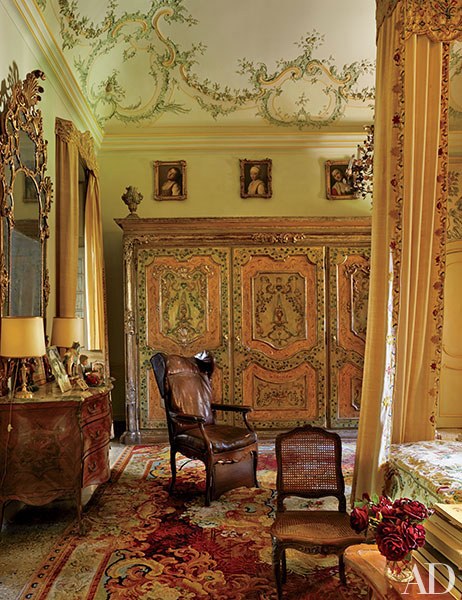
“Gianni Agnelli’s onetime bedroom on the piano nobile features a painted Piedmontese armoire; a Charles X Savonnerie carpet softens the terrazzo floor.”

“Decorated by Stephane Boudin in the 1950s, the Bishop’s Room features antique paintings set within carved moldings, an embroidered bed, and a Louis XV leather-clad sofa.”

I found a few other images of Villar Perosa without any context.
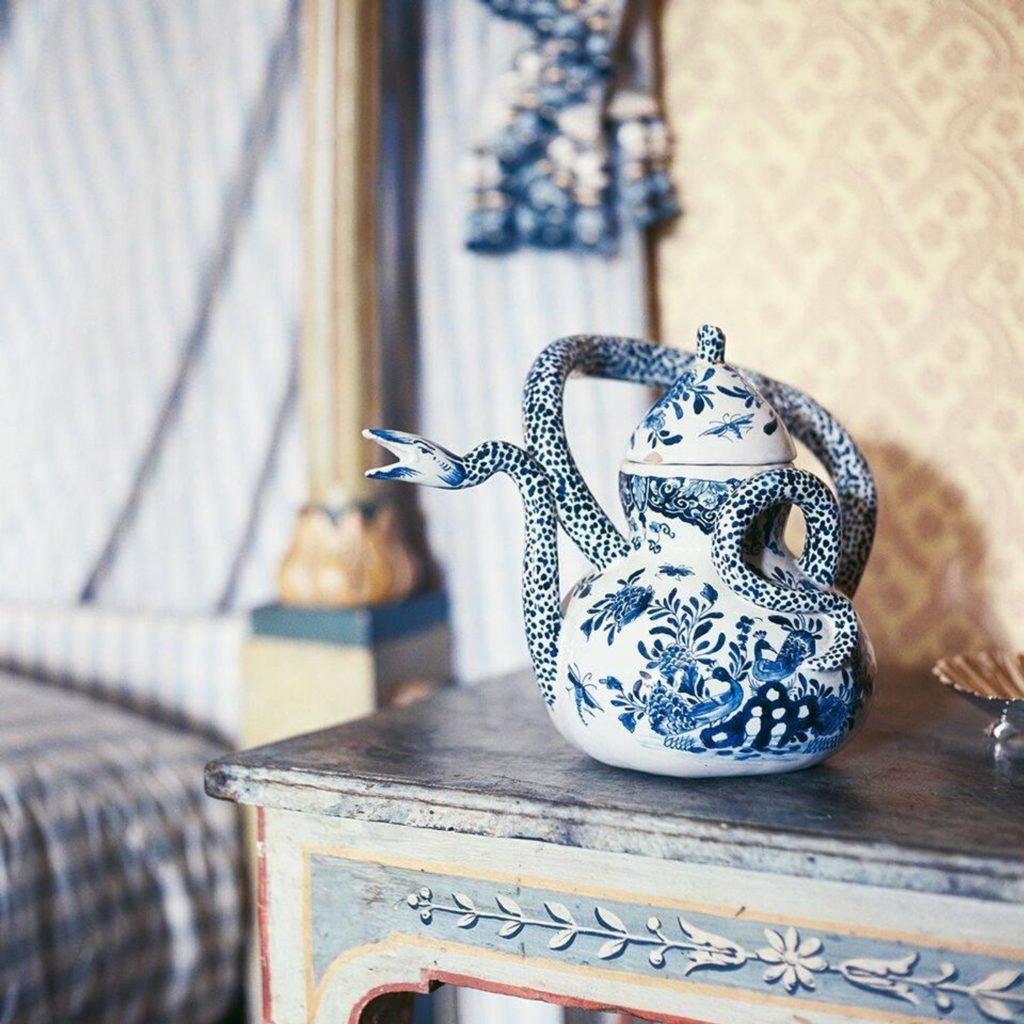

This is another room in which Ginervra Elkann was photographed for Vogue Italia.
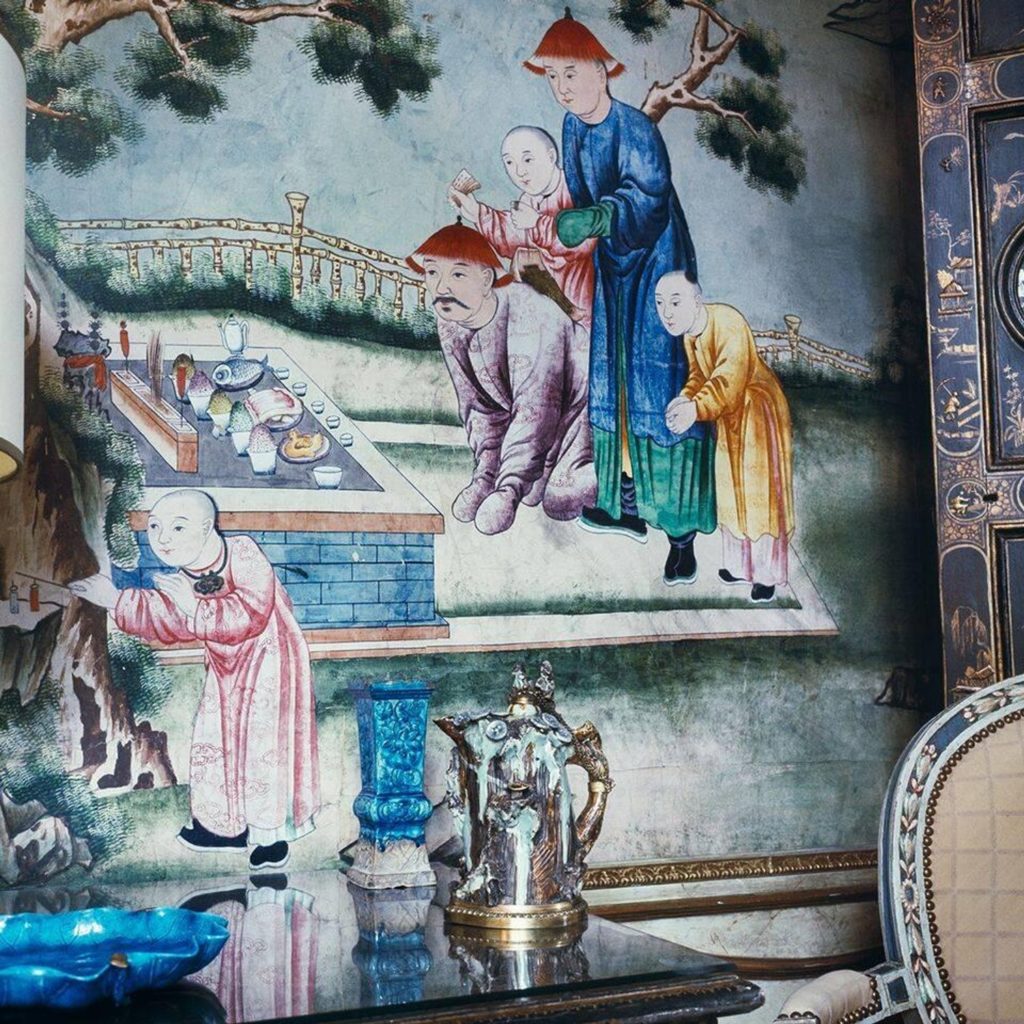
A detail of the room above.

The vine covered children’s wing in the first photo has been attributed to architect Filippo Juvarra in the 1920s. An entrance hall in the children’s wing, with the breakfast room beyond; the painted tall case clock is Louis XV.

Bronze busts and portraits of family members are displayed in the children’s wing. The doors lead to bedrooms, and the large circa-1927 group portrait depicts Gianni Agnelli (left), his sisters Susanna and Clara, and their half-American mother, Virginia Bourbon del Monte.
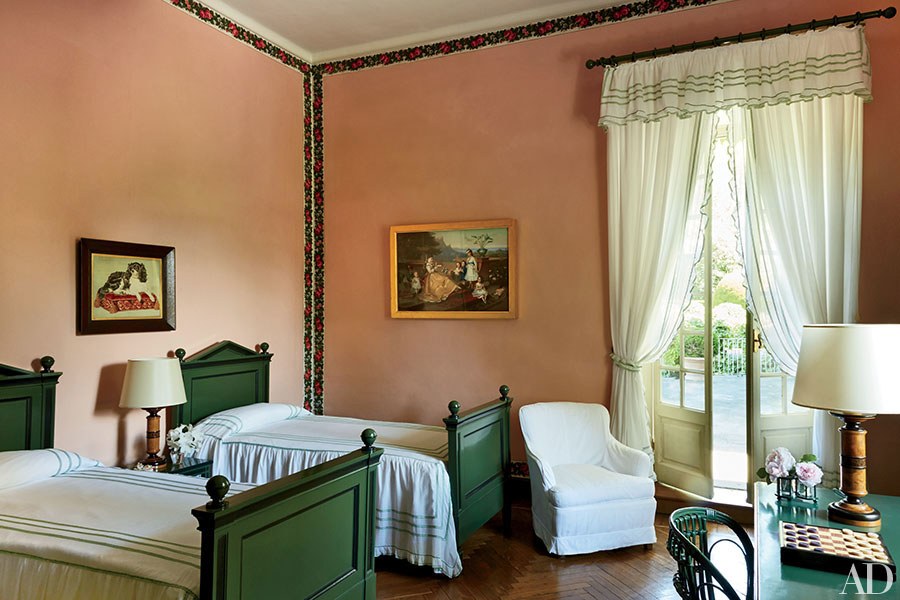
Flowered borders outline a bedroom in the children’s wing; beside the French doors hangs a painting by Constant-Joseph Brochart.
 “With wicker furniture cushioned in bright patterns and finely woven straw matting on the floor, the so-called garden room marks the moment when Marella left behind Boudin’s historicism in favor of her own simpler, contemporary taste. Unlined taffeta curtains with softly ruffled hems became part of her vocabulary, as did cheerful printed fabrics—she even designed an award-winning textile collection in the ’70s.”
“With wicker furniture cushioned in bright patterns and finely woven straw matting on the floor, the so-called garden room marks the moment when Marella left behind Boudin’s historicism in favor of her own simpler, contemporary taste. Unlined taffeta curtains with softly ruffled hems became part of her vocabulary, as did cheerful printed fabrics—she even designed an award-winning textile collection in the ’70s.”
Her trademark wicker furniture is still, to this day, being made by Bonacina Vittorio.
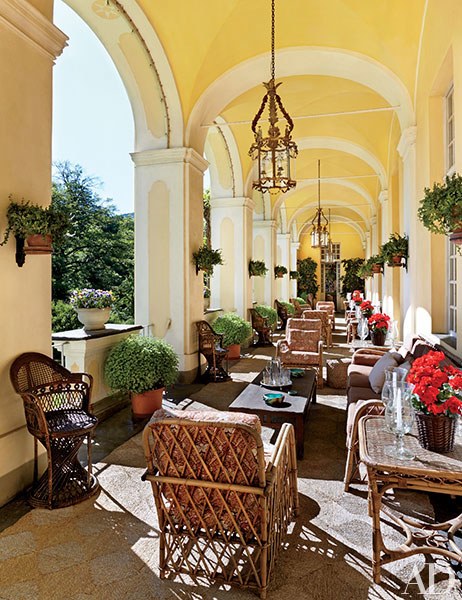
A loggia is outfitted with rattan and wicker furniture.
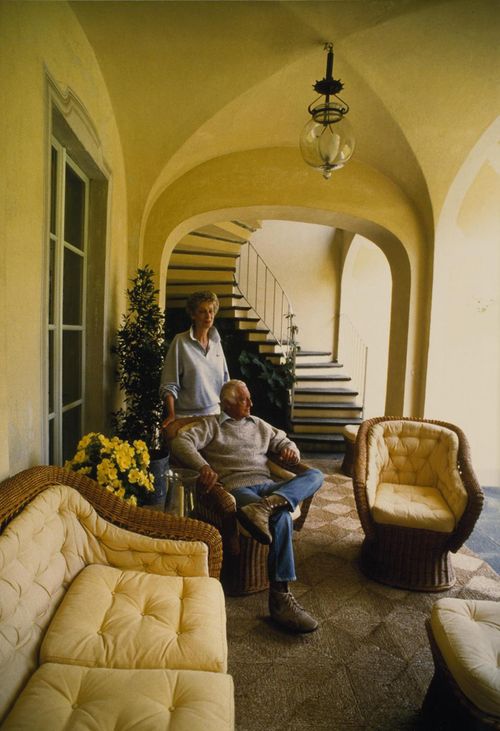
An older photo of Marella and Gianni from 1986.
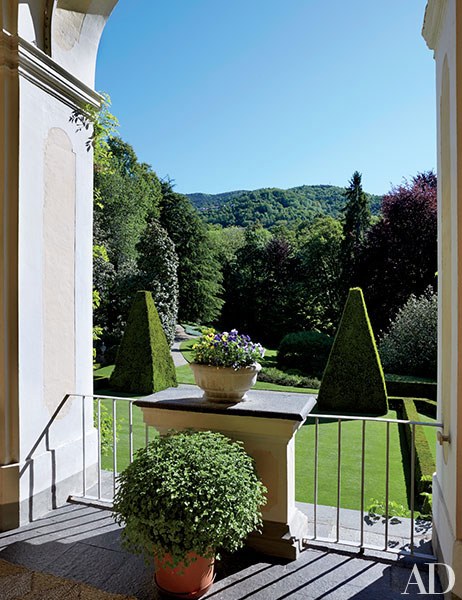
The loggia on the piano nobile overlooks gardens refreshed and clarified in the 1950s by Marella Agnelli and landscape designer Russell Page.
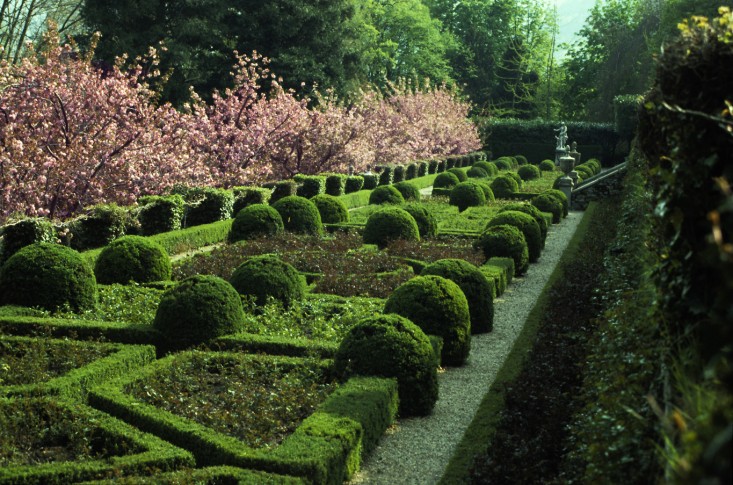
Boudin’s friend Russell Page, the British garden genius, helped Marella clarify the landscape, which she described as having been “a patchwork, each area created by a different generation.”

An aerial view of Villar Perosa. 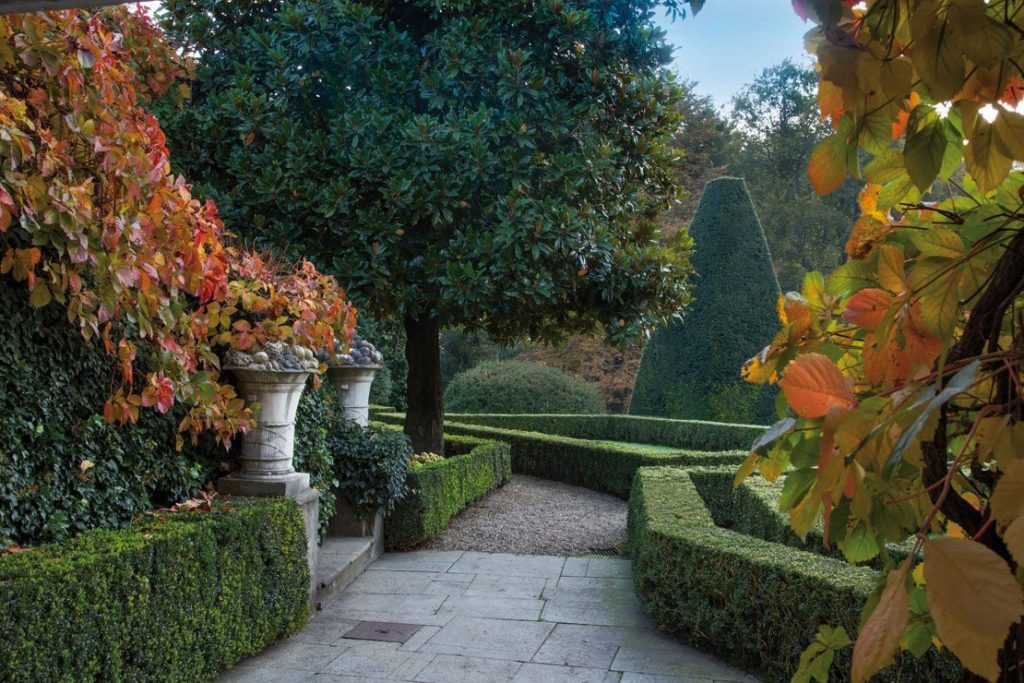
“Anyone who has spent time at Villar joins in the Agnelli traditions. Morning hikes in the foothills of the Alps are typically followed by chess and Scrabble in the garden room. European newspapers are stacked in strategic spots, and books in Italian, French, and English are arranged in baskets on a large table, ready for perusal. There has also been, as long as I can remember, a card table set with a 3,000-piece jigsaw puzzle that takes family and friends an entire month to complete. In hot weather everyone decamps to the swimming pool and the adjacent wood pavilion—as spare as a Zen temple—by architect Gae Aulenti. Landscape designer Paolo Pejrone, a Page disciple, has banked this section with purple heather punctuated by ‘Iceberg’ roses and boxwood clipped into corkscrews and spheres. It is a destination cherished by all, from oldest to youngest, a success that is proof of my aunt’s attention to detail.”

“Villa Perosa has been an intrinsic part of my life now for more than sixty years. It was there that, thanks to Russell, I made my first steps into the fascinating world of gardens. It has been a long journey and the word Russell uttered to me that first evening still ring trier than ever. (One must learn to serve something higher than us all, because if not, one may fall slave to the basest, most material aspects of one’s life.) From a garden one receives much more than beauty. One is enriched by a sense of peace and of expansive openness. In the course of my life I have often retreated to a garden during difficult times. The contact with nature, with the living plants, has been and continues to be a great comfort to me.”
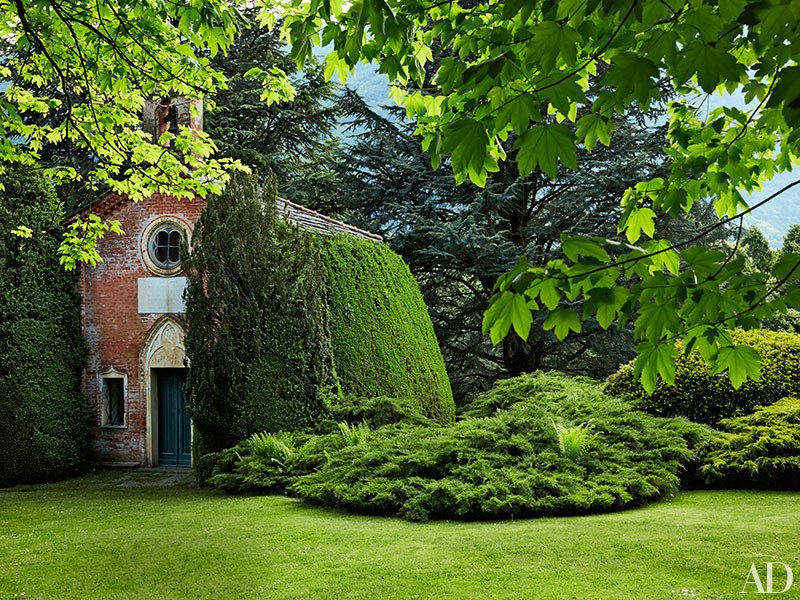
Yews and boxwood embrace the Gothic Revival family chapel.
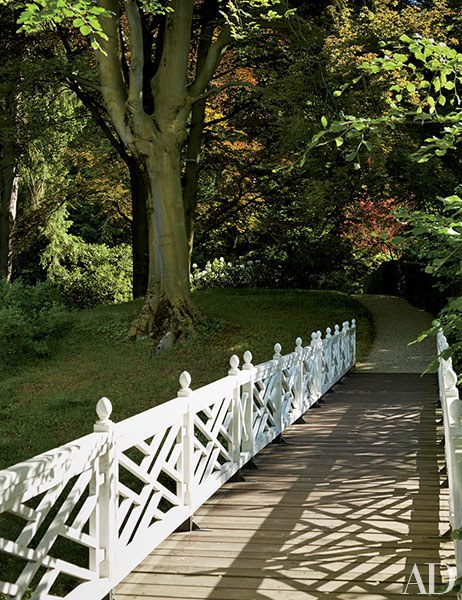
Inspired by 18th-century British architect Sir William Chambers’s chinoiserie work, Page devised a bridge over a small valley in the woodland garden.
 My goal is “creating homes that are truly calm, sheltered places—spas for the soul.”
My goal is “creating homes that are truly calm, sheltered places—spas for the soul.”
Photos are from Architectural Digest, Vanity Fair, and Pinterest.
from Habitually Chic®
No comments:
Post a Comment